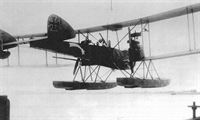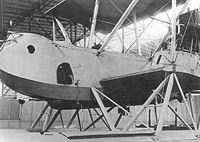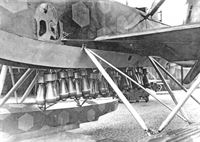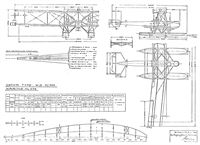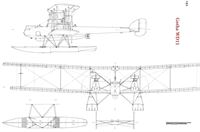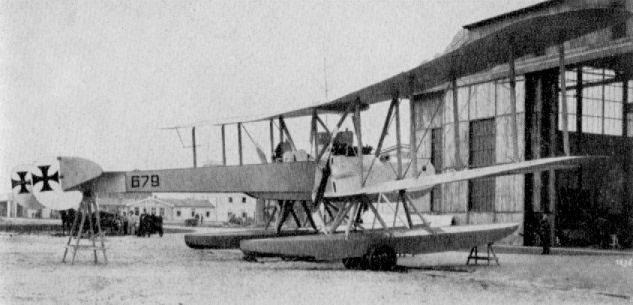
Описание
Страна: Германия
Год: 1917
Варианты
- Gotha - WD.7 - 1916 - Германия
- Gotha - WD.11 - 1917 - Германия
- Gotha - WD.14/WD.20 - 1917 - Германия
- Gotha - WD.22 - 1918 - Германия
- Gotha - WD.27 - 1918 - Германия
- В.Обухович, А.Никифоров Самолеты Первой Мировой войны
- O.Thetford, P.Gray German Aircraft of the First World War (Putnam)
- J.Herris Gotha Aircraft of WWI (A Centennial Perspective on Great War Airplanes 6)
- M.Schmeelke "Torpedo Los!" (Aeronaut)
- M.Dusing German Aviation Industry in WWI. Volume 1 (A Centennial Perspective on Great War Airplanes 84)
-
M.Schmeelke - "Torpedo Los!" /Aeronaut/
Gotha WD11 #991, Lt.z.S. Lowe & Lt.z.S. Thomsen, July 1917
-
M.Schmeelke - "Torpedo Los!" /Aeronaut/
Gotha WD11 MN993, Summer 1917
-
M.Dusing - German Aviation Industry in WWI. Volume 1 /Centennial Perspective/ (84)
Side view of the prototype WD11, Marine Number 679, on a beaching dolley.
-
J.Herris - Gotha Aircraft of WWI /Centennial Perspective/ (6)
WD.11 в испытательном бассейне
The prototype WD11, Marine Number 679, afloat in the Gotha factory pond. Unlike the earlier WD7, the WD11 had its 160 hp Mercedes engines mounted as pushers. The box radiators were mounted directly above the engines. -
J.Herris - Gotha Aircraft of WWI /Centennial Perspective/ (6)
Front view of a WD11 emphasizing its distinctive Gotha appearance. A form of aileron servo is mounted on the outer rear interplane struts.
-
J.Herris - Gotha Aircraft of WWI /Centennial Perspective/ (6)
Front view of the prototype WD11, Marine Number 679, afloat in the Gotha factory pond.
-
M.Schmeelke - "Torpedo Los!" /Aeronaut/
Side view of the prototype WD11, Marine Number 679, afloat in the Gotha factory pond. The attachment and mounting of the aileron servo is clearly seen. To enable it to carry a torpedo, the WD11 was built as lightly as possible and as a result was a fragile aircraft. The powerplants were 160 hp Mercedes D.III engines.
-
M.Schmeelke - "Torpedo Los!" /Aeronaut/
Gotha WD.11 Marine Number 991 plane sank a freighter with a torpedo, becoming one of the few successful torpedo bombers of the war.
The Gotha WD11 aircraft were assigned to the Torpedo-Staffel. On 9 July 1917 Marine Number 991 was brought down by anti-aircraft fire from a ship it was attacking. The crew, Lt. Lowe and Lt.Thomsen, was rescued. -
M.Schmeelke - "Torpedo Los!" /Aeronaut/
Gotha WD11 (993) being hoisted into the water.
-
J.Herris - Gotha Aircraft of WWI /Centennial Perspective/ (6)
WD11 being maneuvered by crane. This WD11 has the hexagonal naval camouflage on upper and side surfaces; the standard naval camouflage pattern specified blue-gray sides without hexagons. Unfortunately, the photograph is too dark to read the Marine Number, but Marine #1376 (last digit unclear, could be #1375) with shooting-star marking is second from right in bottom photo, page 62. The variety of markings on these Lindau-based WD11 s indicates the shooting-star is a personal marking.
-
M.Schmeelke - "Torpedo Los!" /Aeronaut/
Gotha WD11 Marine Number 1376 of the third production batch was ordered in February 1917 and was attached to the 1.Torpedoflugzeug Staffel in Windau. The torpedoman had elaborate aiming gear and a flexible machine gun. Pictured on the far right on the float is Flug-Obermaat Gerhard Hubrich.
-
M.Schmeelke - "Torpedo Los!" /Aeronaut/
Closeup of Gotha WD11 G 1376 in Windau, 1917, showing the forward gunner's station and left engine.
-
M.Schmeelke - "Torpedo Los!" /Aeronaut/
Gotha WD11 photographed with ground crew
-
J.Herris - Gotha Aircraft of WWI /Centennial Perspective/ (6)
WD11s from the last production batch at Windau.
-
M.Schmeelke - "Torpedo Los!" /Aeronaut/
Ground crewmen attach beaching trolleys to Gotha WD11 137X at Windau after the Zerel raid of 8 October 1917. (KMF)
German naval seaplanes returning to their base at Windau after a raid on Oesel Island, October 8, 1917. The aircraft are Gotha WD 11, Friedrichshafen FF 33H, and Albatros W.4 fighters.Другие самолёты на фотографии: Albatros W.4 - Германия - 1916Friedrichshafen FF33 - Германия - 1915
-
M.Schmeelke - "Torpedo Los!" /Aeronaut/
Gotha WD11 overhead Flensburg Fjord.
-
J.Herris - Gotha Aircraft of WWI /Centennial Perspective/ (6)
Gotha WD11 in flight with naval identification streamers attached. Designed and successfully operated as a torpedo bomber, the WD11 was also used for long-range reconniassance and bombing.
-
J.Herris - Gotha Aircraft of WWI /Centennial Perspective/ (6)
Gotha WD11 squadron flight at Flensburg, March 1917. (KMF)
-
J.Herris - Gotha Aircraft of WWI /Centennial Perspective/ (6)
Two Gotha WD11 torpedo bombers being escorted by an Albatros W4 fighter.
Другие самолёты на фотографии: Albatros W.4 - Германия - 1916
-
M.Schmeelke - "Torpedo Los!" /Aeronaut/
A Gotha WD11 overflying a cruiser in the Bay of Kiel.
-
M.Schmeelke - "Torpedo Los!" /Aeronaut/
TeKa mine laying exercise in the Bay of Kiel.
-
M.Schmeelke - "Torpedo Los!" /Aeronaut/
Gotha WD11 taxiing up to a boat retrieving it. Two 160 hp Mercedes D.III engines powered the type; enabling the type to carry a torpedo. However, it was under-powered when doing so; the replacement type designed for this role, the Gotha WD14 was powered by 200 hp Benz Bz.IV engines.
-
M.Dusing - German Aviation Industry in WWI. Volume 1 /Centennial Perspective/ (84)
The Whitehead G/125 torpedo being loaded on a Gotha WD.11, the most successful German torpedo bomber.
-
J.Herris - Gotha Aircraft of WWI /Centennial Perspective/ (6)
Gotha WD11 Marine Number 991 of the first production batch showing the Whitehead G/125 torpedo (45 cm diameter and 753 kg weight) hung in the semi-enclosed fuselage cavity. The wings and cowlings remain to be installed. On 15 June, 1917, this aircraft, crewed by Lt. Lowe &Thomsen, torpedoed and sank the S.S. Kankakee in the Thames Estuary.
-
J.Herris - Gotha Aircraft of WWI /Centennial Perspective/ (6)
Previously identified as a WD14, this isa WD11 configured to carry bombs in place of a torpedo as shown by the pusher engine. The bombs were not carried internally but left to hang externally in this non-aerodynamic manner. The naval hexagonal camouflage was very distinctive on this WD11 and may indicate it had been recovered since being built.
Large calibre bombs were not used against ship targets; from the beginning the principle of dropping a stick of at least five bombs straddling a target was maintained. Experience with the bombsights then in use showed that this was the correct approach. Torpedo-carrying aircraft could carry eight 58kg bombs, and it was the fifth bomb of an eight-bomb stick that sunk the Russian destroyer Stroiny. A Gotha WD 14 bomb load of approximately 300kg is shown here, made up of 10kg bombs, a size commonly used on seaplanes. They are retained by a simple carrying strap across the tail of the bombs. no specially designed bomb cradles being required. -
M.Schmeelke - "Torpedo Los!" /Aeronaut/
The torpedoman's Pintsch aiming device in the nose of a Gotha WD11.
-
M.Schmeelke - "Torpedo Los!" /Aeronaut/
In the bow turret of a Gotha WD11. From left to right: Ltz.S. Rowehl, Lt.z.S. Schurer and Flugobermaat Hubrich. On October 16, Hubrich/Rowehl flew bomb attacks on Russian targets in Gotha WD11 (G 1376), using 58 kg bombs.
-
M.Schmeelke - "Torpedo Los!" /Aeronaut/
Gotha WD11 (679) was transferred from Warnemunde to Flensburg on October 17, 1916. Following a breakage on October 31, 1916, 679 was transported back to Warnemunde for repairs. (KMF)
-
M.Schmeelke - "Torpedo Los!" /Aeronaut/
Above: Gotha WD11 (679) was transferred from Warnemunde to Flensburg on October 17,1916. Following a breakage on October 31,1916, 679 was transported back to Warnemunde for repairs. (KMF)
Below: The floats on Gotha aircraft were again proven to be weak by the wreck of WD11 679. (KMF)
В.Обухович, А.Никифоров Самолеты Первой Мировой войны
Морской бомбардировщик и торпедоносец W.D. 11 имел увеличенные размеры и оснащался более мощными двигателями Мерседес D.III с толкающими винтами. Несколько изменилась и форма фюзеляжа. Было изготовлено 12 машин этого варианта.
Описание:











